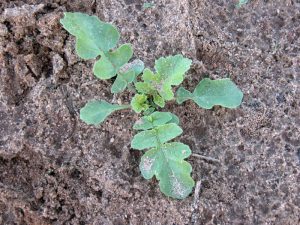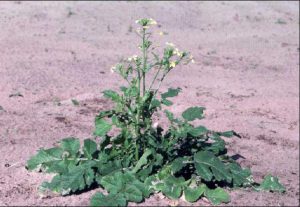
Background:
Wild Radish is often seen in pastures and hay fields during the winter and spring months. Wild Radish can be very difficult to eliminate if allowed to reproduce and become established. This plant produces many seeds that can stay viable in the soil for the next winter. Wild Radish germinate during the fall when soil temperatures drop bellow 65 degrees. It is very important to scout for Wild Radish and catch this winter weed early.
Identification:
Wild Radish can be identified during the rosette stage by the serrated leaves covered in hairs. The rosette can reach fourteen inches in diameter and stays in the rosette stage through most of the winter. Wild Radish can also be identified during the bolting stage. During the late winter to early spring, the plant grows taller and puts on yellow flowers, sometimes white. Increased temperature and daylight hours trigger this stage.

Control:
Prevention of Wild Radish can be done by using certified seed when planting winter forages and keeping grass dense in pastures . Mowing is a less effective and more expensive option. It is best to catch Wild Radish early and treat with an herbicide. Herbicides containing 2,4-D or dicamba (Banvel, Clarity, etc.) are effective and inexpensive when applied before the Wild Radish grows taller than six inches. To avoid injury to grain crops, be sure two to three tillers have formed and the grain crops are four to six inches in height. Applying 2,4-D at 1 pt/acre when Wild Radish are six inches or less in height will provide 90% control. Waiting until the plant is twelve inches tall or flowering significantly reduces chances of control when using 2,4-D. For Bermuda pastures and hay fields only, metsulfuron at 0.2 oz/acre can be used to control mature Wild Radish. Metsulfuron may take three to five weeks to control mature Wild Radish.
For more information on Wild Radish: http://edis.ifas.ufl.edu/wg215
 0
0
